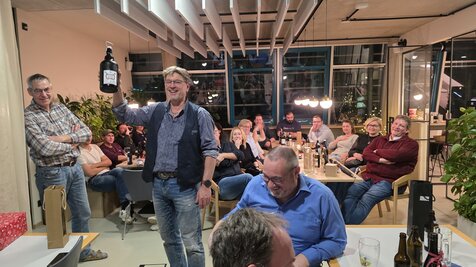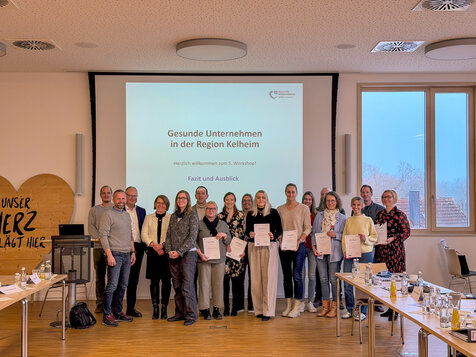
Every year again - our internal Christmas party
Once again this year, we had a wonderful internal Christmas party together. A big thank you goes to our entertainment manager Sonja Eichstätter for organizing the evening.
"Solar power is cheaper than wind power!" Some media almost went into overdrive when they reported the results of the first "joint tender" for solar and wind power plants that became public these days.
https://www.bundesnetzagentur.deBut what is the point of knowing what is "the best", "the cheapest", "the most hidden", "the ...st" renewable energy source? Nothing! Because we citizens of the world actually need them all, responsible politicians need them all, in order to achieve the climate targets. Whether self-imposed or governmentally announced (and postponed): In order to limit CO2 emissions and rising temperatures, we need sun and wind, biomass and hydropower, as yet unknown energy converters, combined heat, power and cooling, and innovative drives. And it cannot make sense to exclude individual technologies because "the other form is better".
Who would have thought at the start of the Renewable Energy Sources Act (EEG) less than 20 years ago, for example, that photovoltaic (PV) electricity could be produced today at an EEG surcharge of less than 4 cents per kilowatt hour (C/kWh)? Nobody. As a reminder: Back then, operators could pocket 99 pfennigs, i.e. around 52 cents per kWh of solar power produced. At the start of this millennium, that was barely enough to cover costs.And - who remembers - an energy conference in the Ruhr region in 1992, when a speaker gave a presentation entitled "Wind energy - the most important renewable energy source"? There were only a few people who criticized the scientist for this at the time and pointed out the need for ALL renewables.The fact that solar, wind and biomass still have to be supported today - in this case by the globally copied EEG law - is not because the "new ones" are too expensive. No: renewables are becoming more and more economical. The technology providers and operators are also doing everything they can to operate in a truly "market economy". In contrast, the market economy has not been (and still is) a criterion for assessing "conventional" energy sources for well over 100 years: on the contrary, the "old" ones have been and still are artificially cheapenedOne example is the CO2 tax, which has not been levied seriously. Even the renowned Kiel Institute for the World Economy (IfW), which is otherwise often critical of green energy, says so. Incidentally, it also believes that the EEG subsidy is not a subsidy. Which is why the IfW does not even include the EEG surcharge in its annually updated list of subsidies.
http://www.dgs.deIn contrast, the IfW criticizes the massive subsidies that are still being cobbled into the old energies from coal to oil, gas and nuclear fuel.
According to public - or backward-looking? - Opinion, nuclear power is the exact opposite. The example of Hinkley Point in the UK, which has not yet been built but is highly praised, shows that operators can only be found if they are promised significantly higher subsidies over decades than the few cents for solar or wind power in Germany. Whether the British have complied with the Aarhus Treaties under international law with the tender, or whether even after Brexit all consumers in the EU will have to pay for this energy without the idea of a final storage facility, are two unanswered questions in any case
But back to the "joint solar-wind tender": many insiders suspect that the tender carried out by the "organizer", which was linked to very confusing conditions, was only intended to create an artificial competitive situation between the two forms of energy, which complement each other in many areas. And when you read headlines such as "PV wins joint tender with onshore wind energy"
you might think: goal achieved.
But it remains to be hoped that the warning voice of the German Renewable Energy Federation BEE will be heard more strongly than before: "It does not seem sensible to put wind and solar in competition with each other, as both technologies are necessary for the success of a cost-efficient transformation of the energy system."
Otherwise, the proponents of old energy could regain the upper hand against cooperatives and community energy. The current "list of winners" of the first joint tender - ranging from EnBW to Vattenfall -
https://www.bundesnetzagentur.de
leaves us fearing the worst for the future. Hope remains: perhaps these are just the last twitches of the "old" energy industry.
(Author: Zukunftsenergie-Team Gammel)

Once again this year, we had a wonderful internal Christmas party together. A big thank you goes to our entertainment manager Sonja Eichstätter for organizing the evening.

Healthy and motivated employees are the foundation of a successful company - especially in economically challenging times. The "Healthy companies in the district of Kelheim" network, in which nine regional companies have joined forces to establish occupational health management (OHM) not as a short-term measure, but as a sustainable and systematic process, follows precisely this claim.

What great news! We are incredibly proud and delighted that, together with our partner IWR GmbH, we have been awarded the planning contract for a 12 MW seawater heat pump including seawater extraction and a biomass heating plant as part of the cross-border UNITED HEAT project.